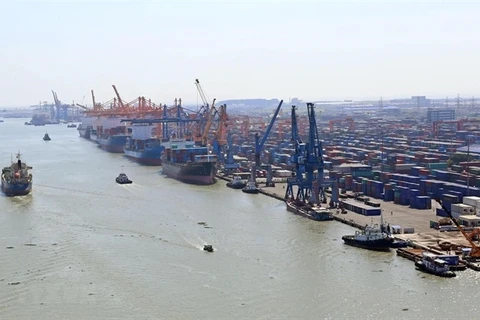Hanoi (VNA) – Vietnam’s export slowed down in July due to the complex developments of the COVID-19 pandemic, especially in Ho Chi Minh City – the country's biggest economic hub, and other localities in the south.
Export slides
The Ministry of Industry and Trade (MoIT) reported that Vietnam’s export earning hit 27 billion USD in July, down 0.8 percent month-on-month and up 8.4 percent year-on-year.
On seven-month calculation, the figure reached 185.33 billion USD, marking a yearly rise of 25.5 percent. Of this, 48.52 billion USD was from the domestic economic sector, up 14.6 percent, and the remaining from the foreign-invested one, inclusive of crude oil, up 29.9 percent.
Twenty-seven goods groups earned over 1 billion USD from export, or 90.2 percent of the total, and five of them brought home more than 10 billion USD or 57.8 percent.
Export of materials and minerals was estimated at 1.87 billin USD, up 1.4 percent year on year while that of processed industrial goods was 164.89 billion USD, up 27 percent. Agro-forestry products raked in 13.65 billion USD and fisheries, 4.92 billion USD, up 16.7 percent and 12 percent, respectively.
The US remained Vietnam’s largest importer that spent 53.6 billion USD, up 37.4 from the same period last year. It was followed by China with 28.7 billion USD, up 24.2 percent, and the European Union, 22.5 billion USD, up 15.5 percent.
Imports in July were estimated at 28.7 billion USD, up 3.8 percent month on month and 29.9 percent year on year.
Seven-month imports rose by 35.3 year on year to 188.03 billion USD, 66.31 billion USD of which were from the domestic sector and the remaining from the foreign-invested one.
Over 1 billion USD was spent on 31 goods groups each, or 87.5 percent of the total import.
China was the largest exporter to Vietnam with a value of 62.3 billion USD, up 48.5 percent year on year. It was followed by the Republic of Korea with 29.7 billion USD, up 19.9 percent, ASEAN 24.7 billion USD, up 48.2 percent, and Japan 12.6 billion USD, up 13.8 percent.
The country ran a deficit of 1.7 billion USD in July, bringing the figure in seven months to 2.7 billion USD.
To help boost production and export, the Ministry of Industry and Trade pledged to tap opportunities from free trade deals, step up export promotion activities post-pandemic, as well as continue developing energy, mechanical engineering industries.
Le Tien Truong, Chairman of the Board of Directors of the Vietnam National Textile and Garment Group (Vinatex), forecast that production and business activities will only recover in September.
It is noteworthy that the labour-intensive garment sector has experienced the most severe impacts since the pandemic broke out, he stressed, suggesting businesses stay updated and draw up flexible plans to ease the impacts.
Solutions to facilitate goods circulation
The double-digit export revenue over the past seven months has reflected great efforts of businesses and managers.
Deputy Minister of Industry and Trade Do Thang Hai described the growth rate of 25.5 percent as a positive sign amid the COVID-19 spread.
There is ample room for trading activities in the time ahead as free trade agreements (FTAs) have been implemented in a more comprehensive and effective manner and are expected to boost Vietnam’s export, the official said.
The EU-Vietnam Free Trade Agreement (EVFTA) is a case in point, he said, adding that many Vietnamese agro-forestry products have seen significant increases in export revenue as compared with the same period in 2019 such as rubber (56,91 percent), rice (3.73 percent), rattan, bamboo, sedge and carpet products (33.75 percent), and vegetables (12.5 percent).
Given the pandemic impact, MoIT leaders have assigned the Industry Department to hold working sessions with associations and enterprises to learn about their difficulties, thus making timely solutions and proposals.
The Vietnam Trade Promotion Agency has also been asked to take solutions to help localities with agricultural consumption.
The agency said it will team up with other relevant agencies, localities and businesses to step up product sale, especially agricultural and aquatic products in southern and Central Highlands provinces.
It will work to connect exporters with importers and promote agricultural products through e-commerce platforms./.























